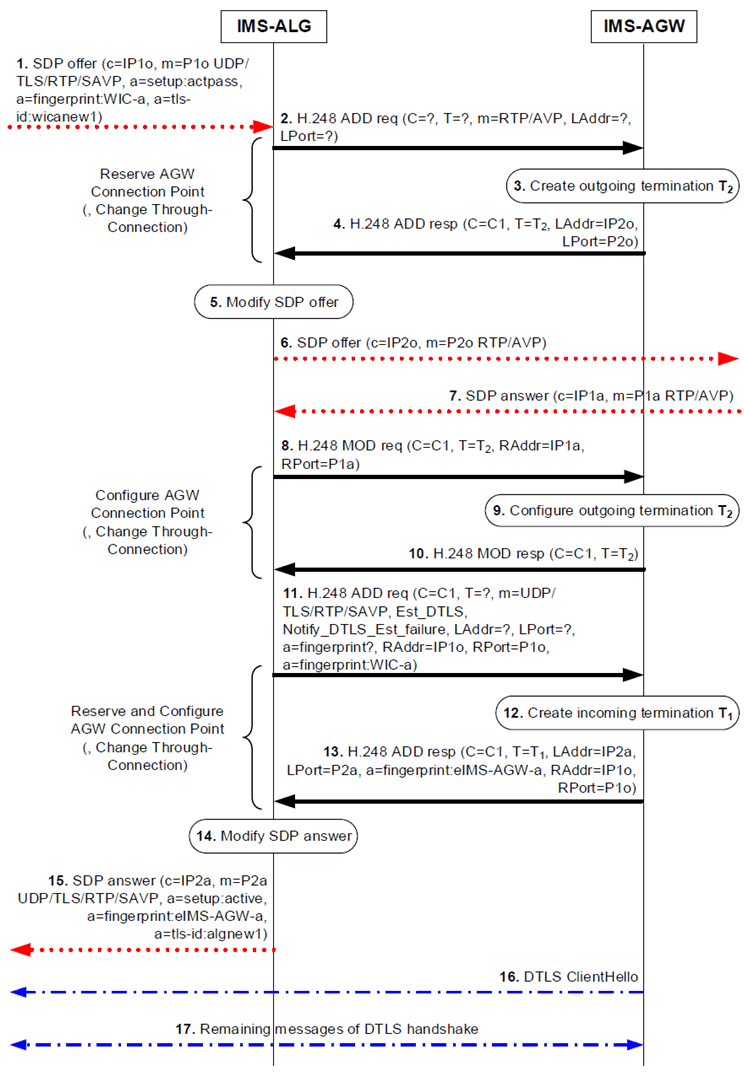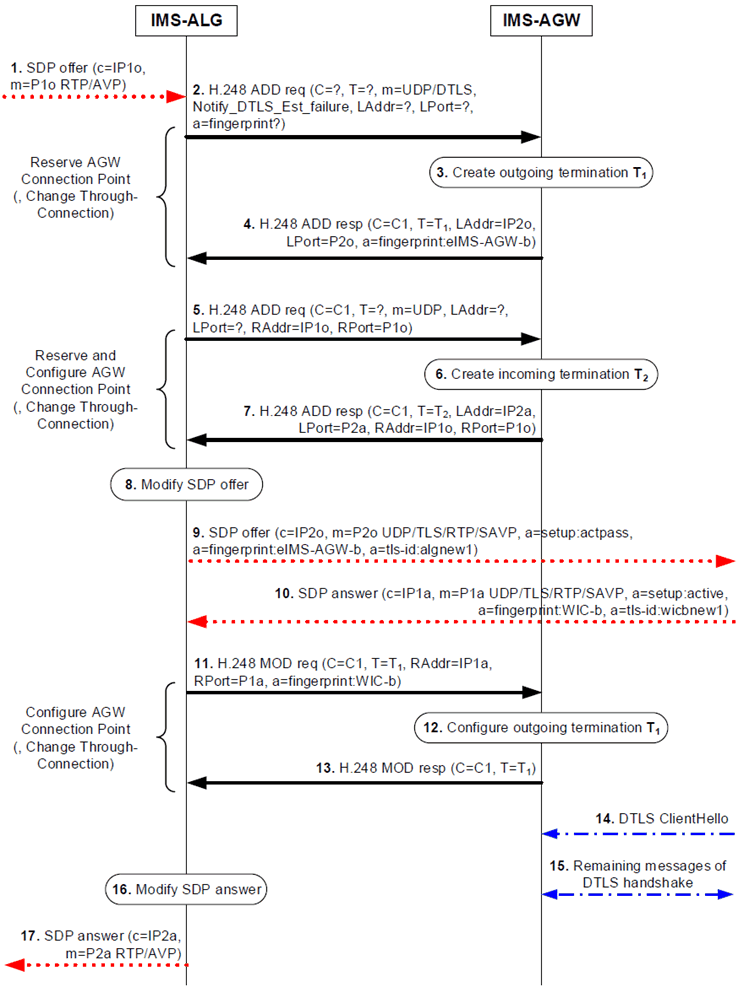Content for TS 23.334 Word version: 17.2.0
1…
4…
5…
5.11…
5.12…
5.14…
5.18…
5.19…
5.20…
5.21…
6…
6.1.6…
6.1.11…
6.2…
6.2.10…
6.2.10.3.1.2
6.2.10.3.2
6.2.10.4…
6.2.10.4.3…
6.2.10.5
6.2.10.6…
6.2.10A…
6.2.13…
6.2.14…
6.2.14.3
6.2.14.4…
6.2.15…
6.2.17…
6.2.17.3…
6.2.17.5…
6.2.18…
6.2.20
6.2.21…
6.2.22…
6.2.22.3…
6.2.22.3.2
6.2.23
6.2.24
6.2.25
7
8…
8.3
8.4
8.5…
8.23…
6.2.10.5 End-to-access-edge security for RTP based media using DTLS-SRTP |R12| p. 114
The procedures are similar to that of clause 6.2.1 apart from the IMS-ALG optionally requesting the eIMS-AGW to provide IMS media plane security using DTLS.
Upon receipt of an SDP offer from the IMS access network, the IMS-ALG shall:
-
check the received value of the setup SDP attribute to determine if the IMS-AGW needs to act as DTLS client or DTLS server. When the received value is equal to:
- "active" the IMS-AGW needs to act as DTLS server;
- "passive" the IMS-AGW needs to act as DTLS client; or
- "actpass" the IMS-ALG shall decide if the IMS-AGW needs to act as DTLS client or DTLS server;
- if the received SDP offer contains "a=tls-id" media-level SDP attribute (as specified in RFC 8842), create a new DTLS association identity;
-
when reserving the transport addresses/resources towards the IMS access network:
- indicate to the IMS-AGW "UDP/TLS/RTP/SAVP" or "UDP/TLS/RTP/SAVPF" as transport protocol;
- include the Remote certificate fingerprint information element with the value of the received fingerprint SDP attribute from the UE (IMS UE or WIC);
- include the Local certificate fingerprint Request information element to request the certificate fingerprint of the IMS-AGW; and
- if the IMS-AGW needs to act as DTLS client, include the Establish (D)TLS session information element to request the IMS-AGW to start the DTLS session setup;
- indicate to the IMS-AGW "RTP/AVP" or "RTP/AVPF" over UDP as transport protocol when reserving the transport addresses/resources towards the IMS core network; and
- remove the setup SDP attribute and indicate the transport protocol "RTP/AVP" in the offer towards the IMS core network.
- in the "m=" line indicating the use of SRTP, change the transport protocol to "UDP/TLS/RTP/SAVP" or "UDP/TLS/RTP/SAVPF";
- insert the fingerprint SDP attribute with the value of the Local certificate fingerprint information element received from the IMS-AGW; and
- insert the "a=tls-id" SDP attribute containing a new DTLS association identity; and
-
insert the setup SDP attribute with the value:
- "active" if the IMS-ALG requested the IMS-AGW to act as DTLS client; or
- "passive" if the IMS-AGW shall take the DTLS server role.

Upon receipt of an SDP offer from the IMS core network using the "RTP/AVP" or "RTP/AVPF" over UDP as transport protocol the IMS-ALG shall:
-
when reserving the transport addresses/resources towards the IMS access network:
- indicate to the IMS-AGW "UDP/TLS/RTP/SAVP" or "UDP/TLS/RTP/SAVPF" as transport protocol; and
- include the Local certificate fingerprint Request information element to request the certificate fingerprint of the IMS-AGW;
- when reserving the transport addresses/resources towards the IMS core network indicate to the IMS-AGW "RTP/AVP" or "RTP/AVPF" over UDP as transport protocol; and
-
modify the SDP offer that will be sent to the IMS access network by:
- in the "m=" line that is indicating the use of SRTP, changing the transport protocol to "UDP/TLS/RTP/SAVP" or "UDP/TLS/RTP/SAVPF";
- inserting the fingerprint SDP attribute with the value of the Local certificate fingerprint information element received from the IMS-AGW;
- inserting the "tls-id" SDP attribute with the new DTLS association identity; and
- inserting the setup SDP attribute, as defined in RFC 4145, with the value "actpass".
-
check the value of the received setup SDP attribute to determine if the IMS-AGW needs to act as DTLS client or DTLS server. When the received value is equal to:
- "active" the IMS-AGW needs to act as DTLS server; or
- "passive" the IMS-AGW needs to act as DTLS client;
-
when modifying the transport addresses/resources towards the IMS access network:
- if the IMS-AGW needs to act as DTLS client, include the Establish (D)TLS session information element to request the IMS-AGW to start the DTLS session setup;
- include the Remote certificate fingerprint information element with the value of the received fingerprint SDP attribute; and
- if not already provided, include the Notify (D)TLS session establishment Failure Event information element to request the IMS-AGW to report the unsuccessful DTLS session setup; and
- remove the setup SDP attribute and indicate the transport protocol "RTP/AVP" in the SDP answer towards the IMS core network.
